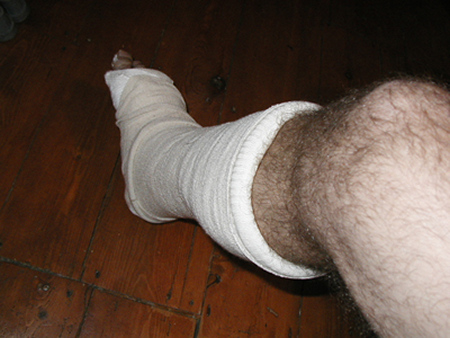I can’t believe it, I wasn’t even cycling, but it was cycling related. I went to the annual dinner and dance this weekend of my road club – Eagle RC. It was a fantastic evening and excellently organized (thanks to our social secretary Alan McArdle). I just wish I hadn’t tried to play my mate Les like a ‘guitar’. We both toppled backwards, fell on my leg and that was it – game over.
If anyone else is in a similar predicament (or finds themselves in one), here’s some useful information on how to encourage the healing process.
The healing process
The body is an amazing thing. When you break a bone, the healing process is activated automatically and immediately. As soon as the fracture occurs, the torn blood vessels form a clot and the surface of the exposed bone at the fracture site dies back 1-2 millimeters because it has no blood supply. Within eight hours, new cells start to be produced which begin to bridge the breakage. Over the next few weeks, the clot is reabsorbed into the body, new capillaries (small blood vessels) form and the cells that have already formed metamorphose into woven osteoblasts and osteoclasts (bone cells). Then the dead bone is reabsorbed into the body and the woven bone cells are replaced by lamely bone, which solidly re-unites the fracture. Finally, the new bone is remodelled to return the whole structure to within the parameters of normality.
After the initial break, you can reduce the inflammation and pain initially by using over the counter anti-inflammatory drugs like ibuprofen. Cooling the area using a cold compress or ice pack will also keep the swelling down. Once the healing process takes hold, it is vital that the fracture site isn’t moved. This is why they cast your limb in plaster. If the two ends of broken bone are moved during the knitting process, the union of the broken bone could be seriously delayed.
In my carefree childhood days I broke my arm falling from a tree. The arm was set in a cast and off I trotted to France for my holidays. I must have driven my parents up the wall as I sulked whilst we I watched my brother frolicking about in the sea. I think I was so miserable that my parents decided to fix a plastic bag over my cast to keep it from getting wet, and of course to shut me up. I think the intention was for me to paddle, but to my parent’s horror, one day they turned up at the beach to find my brother and I bodysurfing on rather large Atlantic waves. Needless to say, a bit of water worked its way into my cast. So much water in fact, that a cast which spanned the entire length of my arm, setting my fore and upper arm at a right angle, now permitted movement of ten to fifteen degrees each way at the elbow. Although the break was at the wrist, this movement at the elbow was sufficient to delay the union of my fracture. I then had to be put to sleep and undergo a surgical operation to re-align my arm, from which I woke only to vomit on ‘sister sledge’ (I think that was the name of the album anyway). The moral of this little anecdote is that in your struggle to function normally, you may seriously delay the healing process, so look after your broken limb. Not that bodysurfing was an entirely normal thing to do
Nutrition
Nutritionally, you should focus all your attention on eating to ‘heal’. If you stick to a healthy balanced diet your body should receive all the nutrients it needs. You may want to reduce the carbohydrate intake slightly and increase the protein at this time by eating more dairy products. Dairy products also contain a lot of calcium, the prime constituent of bone. Milk is probably the most convenient source.
In addition to calcium, vitamin D is vital for bone health and I suggest that you take about 1000mg per day of Cod Liver Oil whilst your fracture is healing. Iron is essential for the maintenance of bone mineral density, so eat lots of spinach and green leafy vegetables and red meat. Also, if you can handle the taste, or are not morally opposed to the consumption of offal, you will gather a lot of iron from it. Alternatively, purchase an iron supplement. There are plenty out there. Finally, manganese (not magnesium) will help to strengthen the fracture site. Good sources for this trace element are again leafy vegetables, nuts, beans and whole grains. Believe it or not, you’ll also get manganese from tea, so I’ll have milk and no sugar if you’re making one!
Expensive therapy
In Germany APT (alpha pulse therapy) has been being extensively made use of to help to speed up the healing and to minimise the trauma and swelling associated with broken bones. The method is painless and is said to be highly effective.
In Britain however hardly anyone has even heard of APT, which not only can assist in the healing of broken bones but also help with a host of chronic degenerative diseases such as osteoporosis. According to the Hale Clinic in London, APT is based on solid scientific research and the most rigorously controlled studies. The research began in 1957 when scientists were amazed to discover that bones produced an electrical signal when squeezed. The electronic frequencies used in APT are ‘very low indeed and totally safe’ said Grace Hart (not related), a physiologist who discovered APT whilst working in Germany.
APT cannot be used if you have a pacemaker or if you suffer from thrombosis and should be avoided during pregnancy. An initial hour-long session will cost £70.00 with half-hour follow-up sessions costing £45.00 each or a series of 10 sessions will cost £375.00.
For more information, contact The Hale Clinic on 020 7631 0156.






